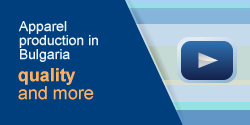|
Bulgarian association of Apparel and Textile Producers and Exporters Member of Euratex |
Become a memberRegister Sign in |
| Български Home Contacts |
ResearchClothing and Textile Industry in Bulgaria in 2008Summary 1. General Economic Environment and Evolution of the Textile/Clothing Industry in 2008 GDP real growth in 2008 was 6% following a good number of years of substantial real growth rates. In nominal terms, the value of the economy reached EUR 34 billion last year. We expect that figure to be at least EUR 36 billion in 2009. Household final consumption is growing steadily as well, as in 2008 it reached EUR 26 billion. However in both GDP and final consumption we expect a substantial decline in nominal terms in 2009. Nominally, measured in euro, GDP grew by 14.5% and 18% respectively in 2007 and 2008. This year nominal growth rate may go down to between 6 and 10 percent. Household expenditures on clothing grew by almost 25% in 2007. By preliminary estimate that figure will be still positive in 2008, however substantially lower - as much as 4% nominal growth. Although no reliable statistics is available on incomes and salaries, some other indirect measures show at their substantial increase in the past few year, particularly the quick growth of deposits, as well as of the imports of durable goods. According to official data purchasing power of the average Bulgarian grew about two times between 2000 and 2008, e.g. salary measured in number of clothing items. In 2008, the average Bulgarian can by as much as 151 men's jackets or 153 dresses with his/her annual salary, according to official statistical office. 2. Evolution of Textile/Clothing Activity Production, measured in real terms, contracted in both textile and clothing sectors in 2008, respectively by 17% and 12% on annual basis. The level of production in the clothing sector in 2008 was at the levels of 2005, and in the textiles it was slightly higher than 2005. Turnovers, measured nominally in euro, contracted by 11% in the textiles segment and by 6% in the clothing sector in 2008 year-over-year. The level of sales in the clothing industry in 2008 was about 19% higher than in 2005, and by 12% higher in the textiles. 3. Factors Influencing Textile/Clothing and their Evolution 3.1. Domestic Demand. We have estimated that the volume of domestic market for clothing in 2008 was some EUR 600 million. That estimation is based on official data on household expenditures and the share of clothing in consumer basket. The market grew by 14% in 2008 - a substantial growth still slower that the one in 2007 (22%). The average annual growth rate has been 12% since 2003. Measured in real terms, the market has grown by 68 percent in the segment of women's clothing for the past ten years. The real growth has been more moderate in the men's clothing segment - only 29% for ten years. 3.2. Exports - Imports The exports of clothing and footwear (reported together in the trade statistics) grew over two times in the period between 2000 and 2007. However in 2008 it registered a drop of almost 8% down to EUR 1.4 billion. The same story applies to the textile exports. They came down by 5.6% to reach EUR 478 million in 2008. Our estimate of the exports of clothing alone (excluding footwear) is about EUR 1.25 billion in 2008. That estimation shows a contraction of exports of about 1.1%. Probably for contraction of footwear exports was quicker the official figure, reporting both sectors, was higher. Contraction of production is confirmed by shrinking volume of imported textiles - by almost 11%. The textile imports came down to EUR 1.25 billion in 2008 from EUR 1.39 billion in 2007. Imports of clothing and footwear grew officially by 29% in 2008 to reach over EUR 360 million. Our estimate of imports of clothing alone (excluding footwear) was about EUR 300, which means a growth of less than 10% on a year earlier. 3.3. Prices Our preliminary estimate for 2008 shows the following average price changes on a year earlier by segment:
As the exchange rate of domestic currency is fixed to the euro, the above can be accepted as well as changes of prices in euro. Meanwhile, the average consumer price inflation in the country was 12.4% in 2008 yearly average. 4. Other Elements Characterizing Textile/Clothing Activity in 2008 4.1. Employment Trends The number of employed in the textile and clothing industries have been declining gradually for the past two years. Employment in those industries fell by 4% in 2007 and then by another 4% in 2008 (based on preliminary data). In 2008, the number of employed in the textile and clothing factories was some 155 thousand, being 161 thousand back in 2007. It is close to 6% of the total employment in the non-farm business sector (excluding budget domains and agriculture). Meanwhile, overall employment in the economy showed the following growth rates in 2008:
4.2 Wages Reliability of the official data on salaries in highly controversial. We advise for all uses to take the below data as lower boundary for the range in which actual wages vary:
Source : BAATPE |
Useful informationResearch Special offers Bulgaria in EU Project Information Fashion News From BAATPE
 |
 |
 |
 |
 |
 |
